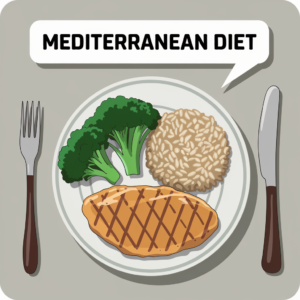The Macrobiotic Diet for Weight Loss: A Step-by-Step Guide for Beginners
Introduction to the Macrobiotic Diet
The Macrobiotic Diet is a holistic, plant-based approach to eating that emphasizes balance, mindfulness, and simplicity. Rooted in the principles of Eastern philosophy, particularly the idea of yin and yang, the Macrobiotic Diet encourages a harmonious relationship with food, the body, and the environment. Traditionally, this diet draws inspiration from  Japanese culture, incorporating natural, seasonal, and organic foods to achieve optimal health and well-being.
Japanese culture, incorporating natural, seasonal, and organic foods to achieve optimal health and well-being.
In the context of weight loss, the Macrobiotic Diet promotes a balanced intake of whole, minimally processed foods such as whole grains, vegetables, legumes, and fermented foods. By eliminating processed sugars, unhealthy fats, and refined carbohydrates, this diet helps reduce caloric intake while providing essential nutrients. With its emphasis on mindful eating and balanced portions, the Macrobiotic Diet offers a sustainable way to shed excess weight while enhancing overall health.
This guide will delve into how the Macrobiotic Diet works for weight loss, its key benefits, potential challenges, and provide practical tips to help you succeed in your journey toward a healthier lifestyle.
How the Macrobiotic Diet Works for Weight Loss
The Macrobiotic Diet promotes weight loss through a combination of whole-food nutrition, mindful eating, and balanced food choices. By focusing on nutrient-dense, low-calorie foods such as whole grains, vegetables, and legumes, the diet helps create a calorie deficit naturally, which is essential for weight loss. Additionally, the high fiber content of these foods promotes satiety, helping control hunger and reduce overeating.
Whole Foods Approach
The diet emphasizes the consumption of whole, natural foods that are minimally processed. This means steering clear of refined grains, sugars, and highly processed products, which are often calorie-dense and nutrient-poor. Instead, the focus is on whole grains like brown rice, barley, and quinoa, which provide complex carbohydrates for sustained energy without spiking blood sugar levels.
Yin and Yang Balance
In the philosophy behind the Macrobiotic Diet, foods are classified into yin (expansive) and yang (contractive) categories. The goal is to maintain balance between these energies by choosing foods that complement each other. Yin foods, such as sugary, highly processed items, are minimized, while yang foods, like whole grains, vegetables, and legumes, are emphasized. This balance supports overall well-being and helps regulate the body’s metabolism, contributing to weight loss.
Mindful Eating
The Macrobiotic Diet places a strong emphasis on mindful eating, encouraging individuals to eat slowly, savor their food, and pay close attention to their body’s hunger and fullness cues. This mindfulness helps prevent overeating and promotes a more intuitive relationship with food. Over time, this practice can reduce emotional eating and lead to more sustainable weight management.
Plant-Based, High-Fiber Diet
The diet’s reliance on plant-based foods ensures a high intake of  dietary fiber, which is key to healthy digestion and weight loss. Fiber adds bulk to meals, helping you feel full longer, while also supporting regular bowel movements and a healthy gut. Whole grains, vegetables, and legumes are all excellent sources of fiber, making the Macrobiotic Diet an ideal option for those seeking to lose weight naturally.
dietary fiber, which is key to healthy digestion and weight loss. Fiber adds bulk to meals, helping you feel full longer, while also supporting regular bowel movements and a healthy gut. Whole grains, vegetables, and legumes are all excellent sources of fiber, making the Macrobiotic Diet an ideal option for those seeking to lose weight naturally.
Key Components of the Macrobiotic Diet
The Macrobiotic Diet is centered around whole, unprocessed foods, with an emphasis on seasonal and locally sourced ingredients. The following are the main components of the diet:
- Whole Grains: Brown rice, barley, oats, quinoa, and buckwheat are staples of the Macrobiotic Diet. These complex carbohydrates provide sustained energy and are rich in fiber, vitamins, and minerals.
- Vegetables: A wide variety of vegetables, particularly leafy greens and root vegetables, are encouraged. Sea vegetables like nori and kombu are also included for their rich mineral content.
- Legumes: Beans, lentils, and other legumes are essential for providing plant-based protein. They also add fiber and help regulate blood sugar levels.
- Fermented Foods: Miso, sauerkraut, tempeh, and kimchi are examples of fermented foods that support gut health by introducing beneficial probiotics into the digestive system.
- Healthy Fats: While fats are used sparingly, sources like sesame oil, flaxseed oil, and nuts are included in moderation to provide essential fatty acids.
- Fish and Seafood (Optional): Although primarily plant-based, the Macrobiotic Diet allows for occasional consumption of fish and seafood, particularly those rich in omega-3 fatty acids, such as salmon and sardines.
Benefits of the Macrobiotic Diet for Weight Loss and Health
The Macrobiotic Diet offers numerous benefits for weight loss, as well as for improving overall health. Here’s how it can positively  impact your body and well-being:
impact your body and well-being:
1. High in Fiber for Satiety and Digestion
The Macrobiotic Diet is naturally high in dietary fiber due to its emphasis on whole grains, vegetables, and legumes. Fiber is essential for promoting feelings of fullness, regulating digestion, and reducing the likelihood of overeating. Research has shown that high-fiber diets support weight loss by improving satiety and reducing overall calorie intake.
2. Promotes Balanced Nutrition
The diet’s focus on whole, minimally processed foods ensures that you’re getting a wide range of essential nutrients, including vitamins, minerals, and antioxidants. This helps support overall health and prevents nutritional deficiencies while you work toward your weight loss goals. Additionally, the emphasis on balance (both in food choices and lifestyle) promotes a well-rounded approach to wellness.
3. Encourages Mindful Eating
Mindful eating is a key component of the Macrobiotic Diet, helping you become more aware of your body’s hunger and fullness signals. By slowing down and savoring each meal, you’re more likely to enjoy your food, feel satisfied, and avoid overeating. This practice also reduces emotional and stress-related eating, which can contribute to weight gain.
4. Reduces Inflammation
The Macrobiotic Diet is rich in anti-inflammatory foods like leafy greens, whole grains, and healthy fats. Chronic inflammation is linked to various health conditions, including obesity, heart disease, and diabetes. By reducing inflammation, the diet can improve overall health and support weight loss efforts.
5. Supports Gut Health with Fermented Foods
Fermented foods like miso and sauerkraut provide beneficial probiotics, which are essential for maintaining a healthy balance of gut bacteria. A healthy gut microbiome is linked to improved digestion, better nutrient absorption, and a stronger immune system, all of which can aid in weight loss and overall well-being.
6. Reduces the Risk of Chronic Diseases
By focusing on plant-based, whole foods, the Macrobiotic Diet may help reduce the risk of chronic diseases such as heart disease, diabetes, and certain cancers. Its emphasis on low-glycemic foods, fiber, and healthy fats contributes to improved cardiovascular health, better blood sugar control, and reduced oxidative stress.
Potential Drawbacks of the Macrobiotic Diet
While the Macrobiotic Diet has many benefits, it’s important to be aware of potential drawbacks:
1. Restrictive Nature of the Diet
The Macrobiotic Diet eliminates many common foods, including dairy, meat (in most versions), refined sugars, and processed snacks. This can make the diet challenging to follow for individuals who are used to a more varied eating pattern. Social situations and dining out may also present difficulties due to the limited food options available on the diet.
2. Risk of Nutritional Deficiencies
Because the Macrobiotic Diet is primarily plant-based, there is a risk of certain nutrient deficiencies, particularly in vitamin B12, iron, calcium, and protein. Careful meal planning is required to ensure that you’re meeting your nutritional needs, and some individuals may need to consider supplementation for optimal health.
3. Time-Consuming Meal Preparation
The diet relies heavily on home-cooked meals made from scratch using whole ingredients. This can be time-consuming, particularly for individuals with busy schedules. However, meal prepping in advance can help mitigate this challenge and make it easier to stick to the diet.
Tips for Success on the Macrobiotic Diet
To succeed on the Macrobiotic Diet and achieve your weight loss goals, consider these practical tips:
1. Focus on Whole Grains and Vegetables
Make whole grains, such as brown rice, quinoa, and millet, the foundation of your meals. Pair them with a variety of colorful vegetables to create balanced, nutrient-dense dishes. These foods will provide the fiber and nutrients needed to support your weight loss journey.
2. Practice Mindful Eating
Take your time to enjoy your meals. Eat slowly and without distractions, paying attention to the flavors and textures of your food. Practicing mindful eating can help you become more aware of your body’s hunger and fullness cues, reducing the likelihood of overeating.
3. Incorporate Fermented Foods
Fermented foods are rich in probiotics, which support gut health and digestion. Incorporate foods like miso, tempeh, and kimchi into your daily meals to promote a healthy gut and enhance your overall well-being.
4. Plan Your Meals in Advance
Since the Macrobiotic Diet requires more preparation than typical diets, it’s helpful to plan your meals in advance. Cook grains, beans, and vegetables in bulk to save time throughout the week and avoid the temptation of processed convenience foods.
5. Stay Hydrated with Water and Herbal Teas
Drink plenty of water and herbal teas to stay hydrated throughout the day. Avoid sugary beverages and focus on drinks that support digestion, such as green tea, ginger tea, or chamomile.
Scientific Evidence and Case Studies
Research on plant-based diets like the Macrobiotic Diet supports its benefits for weight loss and overall health. A study published in the Journal of Nutrition found that individuals who followed a high-fiber, plant-based diet experienced significant weight loss and improvements in metabolic health. Additionally, fermented foods have been shown to improve gut health, which can aid in digestion and weight management.
In addition to weight loss, plant-based diets are linked to a lower risk of chronic diseases such as heart disease and type 2 diabetes. These findings suggest that the Macrobiotic Diet may be an effective tool for both weight management and long-term health.
Who Should Try the Macrobiotic Diet?
The Macrobiotic Diet is a good option for individuals who:
- Prefer a plant-based, whole-foods approach to weight loss.
- Are interested in mindful eating and balance in food choices.
- Want to reduce their intake of processed foods, sugars, and unhealthy fats.
- Are willing to spend time preparing meals and cooking at home.
Who Should Avoid the Macrobiotic Diet?
While the Macrobiotic Diet works well for many, it may not be suitable for everyone. You should avoid this diet if you:
- Have specific dietary needs that require higher levels of animal-based nutrients (such as vitamin B12 or calcium).
- Prefer a more flexible eating plan with a wider variety of food options.
- Don’t have the time or resources for frequent meal preparation.
Conclusion
The Macrobiotic Diet is a plant-based, whole-foods approach that promotes balance, mindful eating, and long-term weight loss. By focusing on whole grains, vegetables, legumes, and fermented foods, you can achieve your weight loss goals while improving overall health. While the diet may be restrictive and require careful planning to avoid nutrient deficiencies, its emphasis on natural, minimally processed foods makes it a viable option for those seeking a holistic approach to wellness.